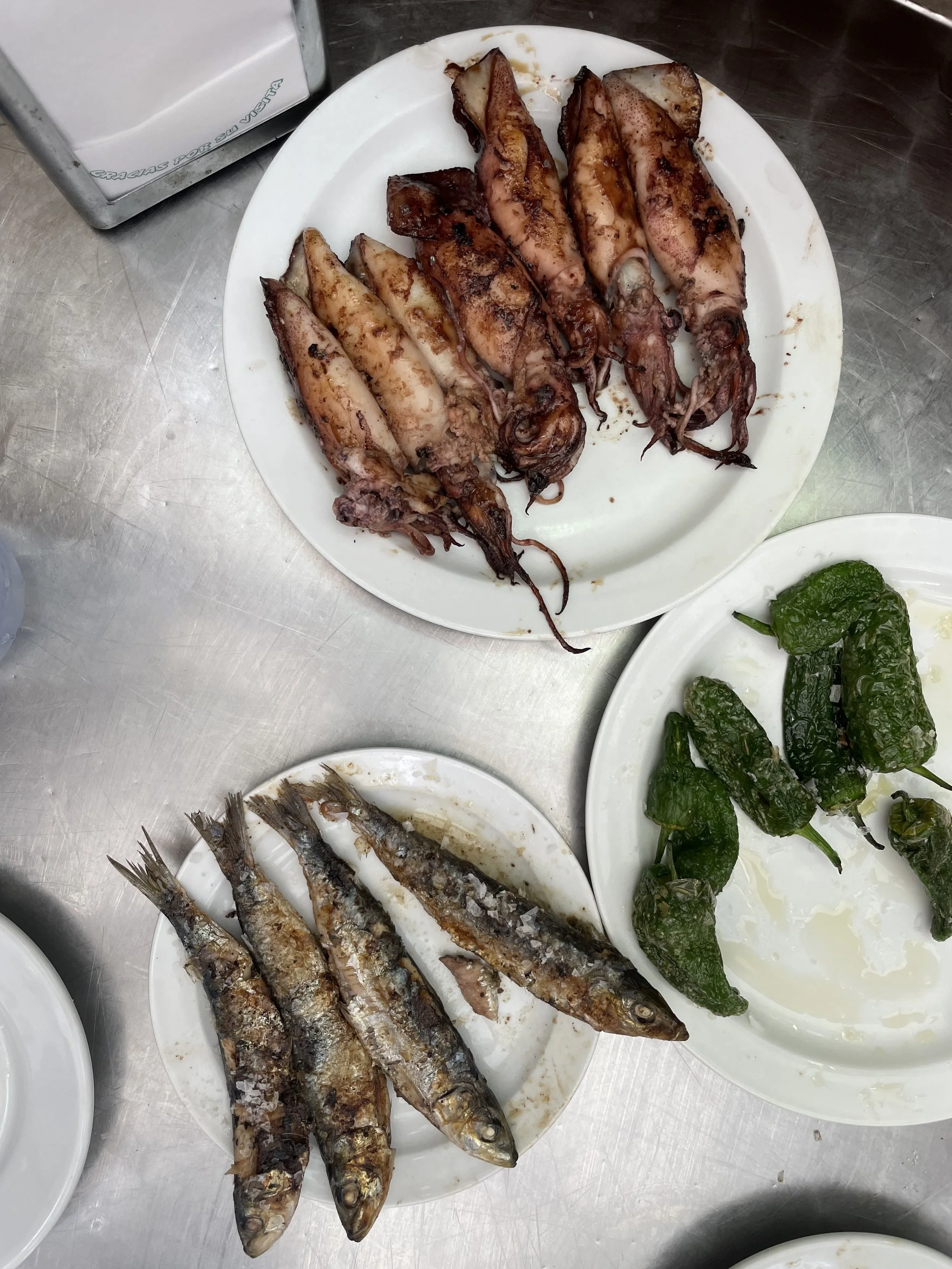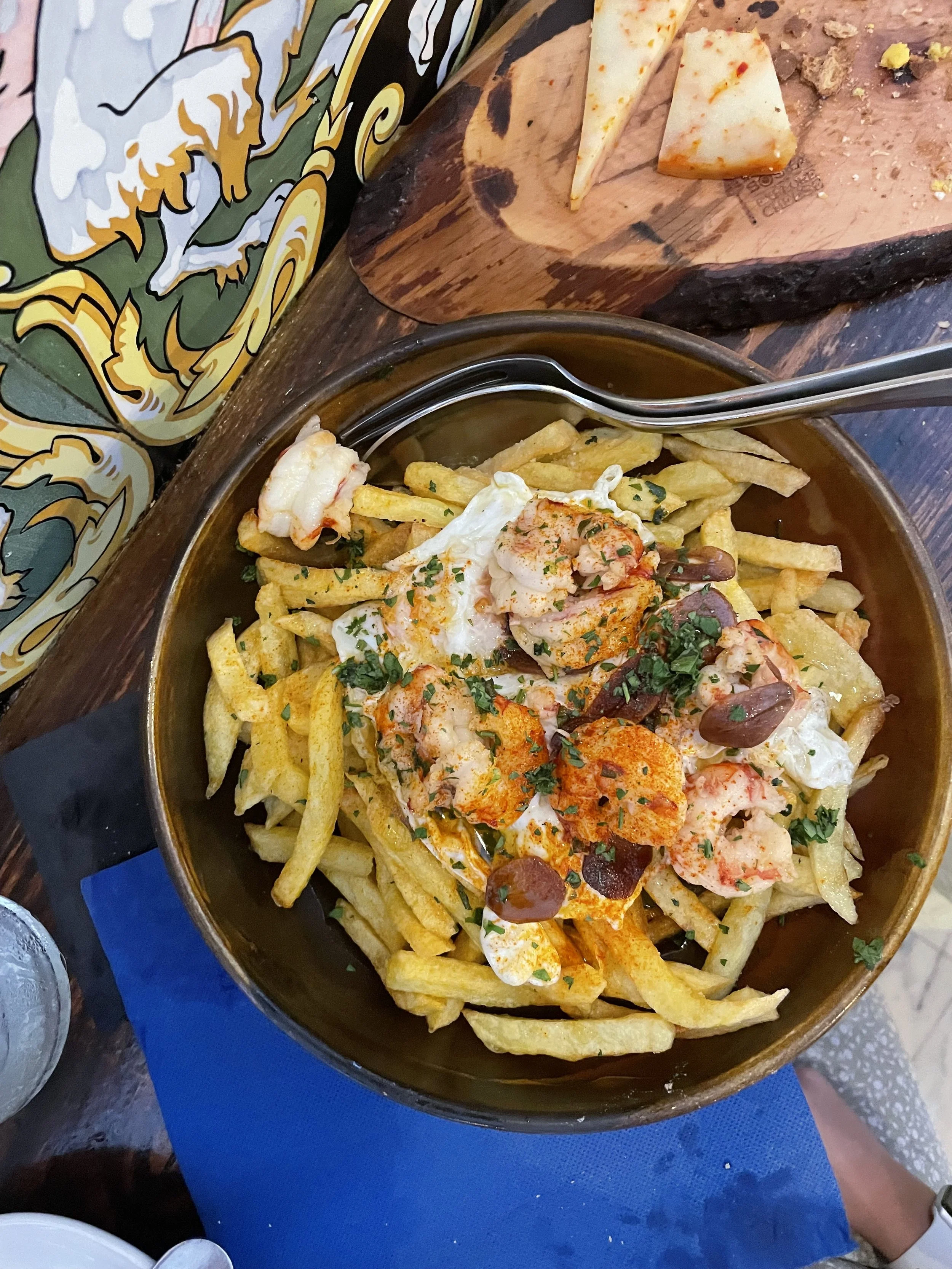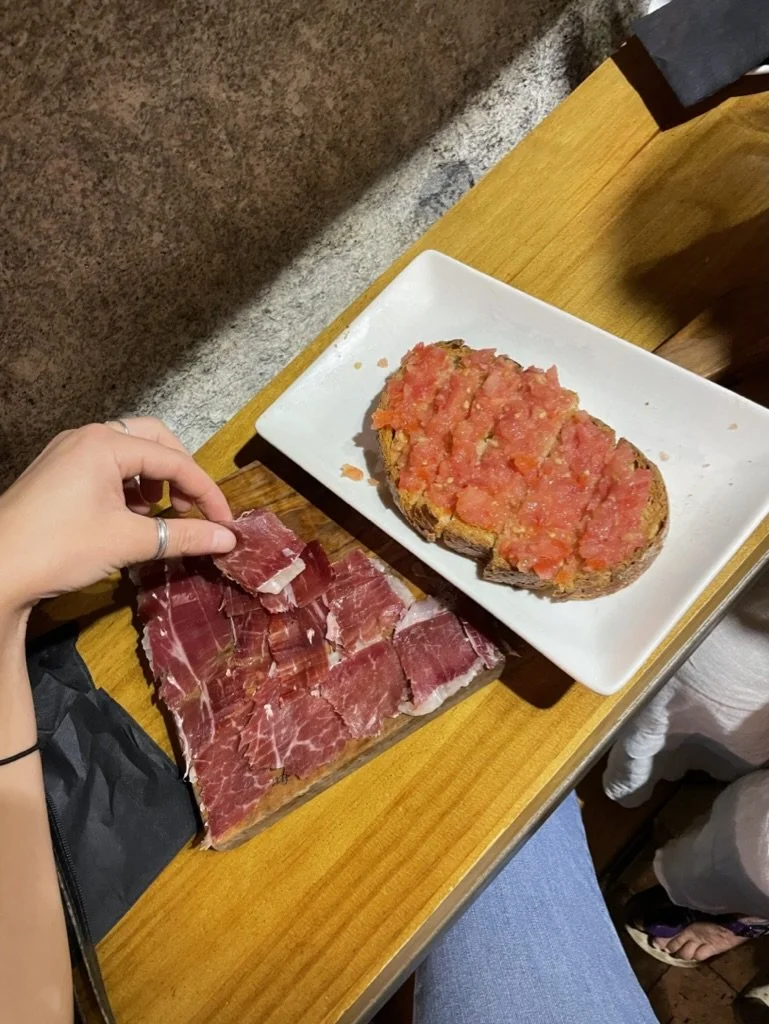El Tapeo: A Food Ethnography
A moment in Madrid’s tabernas.
Today, el tapeo isn’t simply a portion size, or mealtime, or after-hours activity. It is all those things and none of them.
A woman reaches along the narrow bar top to pull a paper napkin out of the dispenser, brushing elbows with a stranger. A colleague? They look at each other and half smile to acknowledge the fleeting intimacy. Everyone here seems like they know each other, punctuating the perimeter of Casa Macareno with little room between groups. The bar was built in 1920 and totes original tiling of the façade, documentation of the many names it’s operated under since then. A chest- high, barely foot-deep counter lines the mosaic walls and supports the weight of assorted foods, beers, handbags, and forearms. People lean fondly into each other and their fare, or tapas. Each party is started with a plate of olives.
The menu includes standard dishes: a board of jamón, or sliced ham; pan con tomate, bread with tomato and olive oil rubbed into the crumb; huevos rotos con camarones, fried eggs on a bed of French fries topped with seasoned shrimp; and a tabla de quesos, a cheese board, that features the usual hard Manchego, a soft gorgonzola, and a luxurious wheel of creamy, velvety goat cheese carrying a dollop of truffles and a drizzle of honey. In the back is a dining room housing marble-top tables and Thonet-style chairs painted white. A small handful of people are seated to eat, but most hover in the front room, crowded along the bar and its runoff countertops. Behind the beer taps hangs a colorful Joan Miró print that looks perfectly at home in the vibrant bar. The loud hum of warm conversation drowns out background music and is cut, almost like staccato notes, by brief bursts of laughter.
Tapas bars—tascas, or tabernas—are generally like this. There’s a template, a scaffolding, that seems to define them, and each place fills in the blanks with its own energy, or onda. Some feel more dated, rooted in time and tradition, but lively nonetheless. Others pander to tourists, dimly lit with narrower windows and employees that circle the sidewalk out front, summoning folks inside. For the most part, they share the bones of a similar menu: traditional tapas dishes. The word ‘tapa’ translates to ‘lid’ and comes from the verb tapar, which means ‘to cover.’ It’s said that tapas got their name from the early use of ham or cheese to cover drinks and keep dust or flies from entering. Legend has it that the custom began in the thirteenth century when King Alfonso X was prescribed high amounts of wine to treat an illness. To mitigate the effects of the alcohol, he ate small portions of food with each drink. The strategy’s success resulted in household recommendations to serve a bit of food along with alcoholic beverages.
Today, el tapeo isn’t simply a portion size, or mealtime, or after-hours activity. It is all those things and none of them. It’s a social practice, a norm, an anchor around which community and culture and regional recipes float. Contemporarily, tapear may serve the same function as teatime or a pint at the pub—gathering socially in celebration or commiseration at a public food and beverage establishment—but its societal impact is quite different. While small portions of staple dishes can be prepared at home alongside a glass of wine or a caña (half-pint of beer), this wouldn’t be filed under the tapas category. Tapas are meant to be had out at the bar, never alone, always in community. Everyone partakes. The practice is essential to every social group; while class certainly plays a role, it’s not a barrier to entry. Tabernas and tascas are landmarks in city barrios, or neighborhoods, as well as pueblos, the small towns dotting Spain’s countryside.
In Madrid, many of these establishments can be spotted from down the street. People, often younger, spill out onto the sidewalk with cigarettes dangling between their index and middle fingers. Sometimes the tascas are hidden, tucked away on side streets, while others—particularly those that cater to travelers—line the chaotic streets surrounding tourist zone Puerta del Sol. The quieter, more unsuspecting ones that speckle the hills of historic literary neighborhood Las Letras require some wandering to be stumbled upon.
Casa Alberto opened its doors in 1827 and still maintains its original façade. It’s located on Calle de las Huertas, just a few steps from Plaza Santa Ana and trendy hotels. The walls are lined with photos of diners over the years and wood moldings, intricately carved, decorate the ceiling. In the back dining room, the tables are covered in white cloths and butcher paper—typical of the more traditional establishments. Here, the dishes are classic Madrileño tapas fare: callos (tripe), carrillada de ternera (veal cheek), croquetas (croquettes), sardinas ahumadas (smoked sardines), among many others. Callos, when done right, should leave the lips sticky, mouth parched. Here, they’re done right.
El Diario, which was built in 1879, sprawls in comparison. It occupies the entire corner of Huertas and Jesús, and feels more like a restaurant in many ways. Instead of relegating seated meals to a back dining room, the largest part of the restaurant holds four-and-six tops, and even a large table for big groups. Hunched at the bar counter are only a handful of customers, mostly older men. On El Diario’s outer wall, little chalkboards are hung to display snippets of the menu, unexpectedly advertising vegan options in English. Chalkboards like this are quite common; whether scrawled on an easel propped up on the cobblestone or floating like a series of picture
frames that peer down at the narrow sidewalks. Inside, a server balances two dishes in each hand while he sturdily climbs the steps that separate the bar from the rest of the place. One of them is a steaming mini cast iron skillet on a wooden base. Sizzling in it are shell-on prawns in sauteed garlic, or gambones al ajillo. He leans down to drop the skillet and a plate of blistered pimientos (peppers) with one arm before dropping two desserts with the other arm a few tables away: a tiramisu and a slice of tarta de Santiago, the Spanish almond cake with purported roots in the Middle Ages.
This variety of taberna often began, and still identifies as cervecerías, or breweries, though food and tapas take up a large share of their output. Their long and sometimes circuitous origin stories are sources of great pride and continue to have a strong hold on their classic feel today. Quintessential tiling, dark wood, and narrow bars, they’re often smaller but remain central to their communities. Some of these establishments, while built in the early or mid-twentieth century, pride themselves on iterating to keep up with their everchanging environments. Avant- garde lighting fixtures, contemporary takes on traditional dishes, updated business models, and significantly higher prices—even in comparison to tascas with much shorter lifespans—are just a few of the changes commonly made.
Alimentación Quiroga, which started operating in 1958, nearly has a cult following today (and rightfully deserved). It has all the makings of a traditional tasca but appeals to a younger crowd; its website goes so far as to say, ‘From nine in the morning to twelve at night, you can “do the shopping,” have a coffee or a glass of wine, in a grocery store that has evolved with the trends of the twenty-first century.’ Its community contribution in the late fifties was that of a local grocery
store. In Madrid, alimentaciones are convenience stores, and the Quiroga family sought to offer a food shop in Las Letras where products could be tasted and consumed onsite. Today, it operates as a place to eat and drink with an extensive wine list and deli counter. Each of these high- quality products are available for purchase, among plenty others. So many, in fact, that guests are bumping knees with cracker boxes, piled like Jenga towers, that live under narrow makeshift dining counters. It’s a bounty of delicacies that’s visible before one even enters the place.
Like many retail establishments, particularly those that have been around longer, Alimentación Quiroga’s display window boasts its wares: embutidos and fiambres (dried meats and cold cuts), boxes of gourmet tinned fish, wheels of cheese, and one enormous wheel of parmesan with whole scoops taken out each time it’s ordered. They also have fewer hot items on the menu, likely a direct result of their modified kitchen that includes only a microwave for cooking. They’re not a place that tries to do it all, but rather one that does what they do best. Their most decadent offering is a discrete upgrade to a classic dish: their foie con higo, a rich but delicate duck patê with a thin layer of fig pressed into its center. Their tapas are served on butcher paper, ready to be crumpled when empty, instead of occupying counter space.
The more atypical menu items are their salads—arugula with mandarin slices, goat cheese, and a balsamic glaze—that seem to favor a younger, more plant-focused clientele. A hightop seats two audibly American women, maybe in their mid twenties, who stare at others in the window reflections. Behind them, among a loud group of boys; all but one are from Spain, and the last seems to be a friend visiting from London. In the back corner a couple is seen kissing, almost egregiously.
Some of these food-centric bars highlight fish, which seems almost like a contradiction for landlocked Madrid. The city historically receives seafood from coastal regions of the country, like Asturias, Andalusia, Galicia, and nearby Valencia. Marisquería La Paloma in hilly Lavapiés has been serving fish since 1960 and is a locally-known destination for gambones and boquerones en vinagre, anchovies marinated in vinegar with garlic and parsley. Anchovies’ long-preserved history in Madrid comes from conservation techniques used since the nineteenth century. Oil and vinegar both maintain and draw out their salty flavors.
Here, the counters and stools are all stainless steel, and the sound of beer glasses hitting metal rings all the way down the narrow bar. Fluorescent lights bounce off the reflective surfaces. One wall is completely mirrored and in it patrons steal glances at one another. People surrounding the bar are quite a bit older than in other locations, and they are all evidently Spanish. They stare at the foreigner and make no effort to hide it, pushing each other down the counter and turning their backs.
Bar Santurce lives not far from La Paloma and opened in 1970. Its famous sardinas a la plancha, or grilled sardines, are thick and sprinkled with salt flakes, leaving the mouth parched. Generally ordered with pimientos, there is little else on the menu. The place is small and operates only a few hours a day. A handful of tables, maybe ten or so, fill the floor, but remain empty save for one. Sizzles from the grill are the only music to be heard. It seems very little has changed since its debut, and there is a character about it that feels both unique and strangely familiar at the same time.
Tapas, tapeo, tascas, tabernas are a main tourist attraction that draws people in from all over the world precisely because they’re iconic, vernacular, and quintessentially Spanish. The consistency of it all somehow also includes great variety. One knows what to expect in many ways but can always, always be surprised. Each serves small plates alongside a drink. They are all places for people to gather socially, engage in conversation, and in communal experiences. A set of traditional dishes establish history, culture, and customs, but there is plenty of room for play— even in bars that have been around since the nineteenth century. The pride of a place can be its final destination for some, or a starting point for others.




